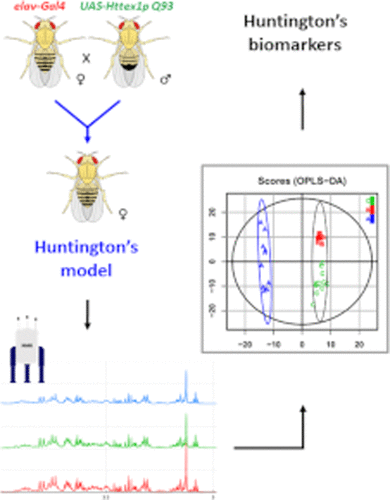当前位置:
X-MOL 学术
›
J. Proteome Res.
›
论文详情
Our official English website, www.x-mol.net, welcomes your feedback! (Note: you will need to create a separate account there.)
Metabolomic Nuclear Magnetic Resonance Studies at Presymptomatic and Symptomatic Stages of Huntington's Disease on a Drosophila Model.
Journal of Proteome Research ( IF 4.4 ) Pub Date : 2020-09-03 , DOI: 10.1021/acs.jproteome.0c00335 Marylène Bertrand 1 , Martine Decoville 1, 2 , Hervé Meudal 1 , Serge Birman 3 , Céline Landon 1
Journal of Proteome Research ( IF 4.4 ) Pub Date : 2020-09-03 , DOI: 10.1021/acs.jproteome.0c00335 Marylène Bertrand 1 , Martine Decoville 1, 2 , Hervé Meudal 1 , Serge Birman 3 , Céline Landon 1
Affiliation

|
Huntington’s disease (HD) is an inherited neurodegenerative disorder, for which diagnostic development and discovery of new therapeutic targets are urgently required. In this study, a model of HD in Drosophila melanogaster has been used to identify metabolic biomarkers at presymptomatic and symptomatic stages of the disease. The pan-neuronal expression of a pathogenic fragment of the human Huntingtin (HTT) protein containing a 93-repeat polyglutamine expansion (Httex1p Q93) in transgenic flies induces a neuropathology with several characteristics of the human disease. The discriminant metabolites between the diseased flies and their controls were identified by 1H nuclear magnetic resonance and orthogonal partial least squares discriminant multivariate analysis. The experiments carried out with 10-day-old flies allowed us to identify a set of 10 biomarkers of the presymptomatic stage: NAD+, AMP, fumarate, asparagine, dimethylamine, β-alanine, glutamine, succinate, glutamate, and ethanol. Remarkably, the experiments conducted with 16-day-old flies, when the symptoms of the disease were present, highlighted a different set of 6 biomarkers: phosphocholine, ethanolamine, 2-oxoglutarate, succinate, pyruvate, and acetate. Our results provide a better understanding of the metabolic impairments in a widely used HD model and demonstrate that metabolism perturbations change dramatically during the development of the disease.
中文翻译:

果蝇模型在亨廷顿氏病症状前和症状期的代谢组学核磁共振研究。
亨廷顿舞蹈病(HD)是一种遗传性神经退行性疾病,因此迫切需要诊断开发和发现新的治疗靶标。在这项研究中,果蝇的果蝇高清模型已用于鉴定疾病症状前和症状期的代谢生物标志物。泛神经元表达人类亨廷顿(HTT)蛋白的致病性片段,该蛋白在转基因果蝇中含有93个重复的聚谷氨酰胺扩增(Httex1p Q93),可诱发具有人类疾病若干特征的神经病理学。病蝇与对照之间的鉴别代谢物由1标识H核磁共振和正交偏最小二乘判别多元分析。用10天大的苍蝇进行的实验使我们能够鉴定出症状前阶段的10种生物标记物:NAD +,AMP,富马酸,天冬酰胺,二甲胺,β-丙氨酸,谷氨酰胺,琥珀酸,谷氨酸和乙醇。值得注意的是,当出现疾病症状时,对16天大的苍蝇进行的实验突出了6种生物标志物的不同集合:磷酸胆碱,乙醇胺,2-氧戊二酸,琥珀酸盐,丙酮酸和乙酸盐。我们的结果更好地了解了广泛使用的HD模型中的代谢损伤,并证明了在疾病发展过程中,代谢扰动发生了巨大变化。
更新日期:2020-10-02
中文翻译:

果蝇模型在亨廷顿氏病症状前和症状期的代谢组学核磁共振研究。
亨廷顿舞蹈病(HD)是一种遗传性神经退行性疾病,因此迫切需要诊断开发和发现新的治疗靶标。在这项研究中,果蝇的果蝇高清模型已用于鉴定疾病症状前和症状期的代谢生物标志物。泛神经元表达人类亨廷顿(HTT)蛋白的致病性片段,该蛋白在转基因果蝇中含有93个重复的聚谷氨酰胺扩增(Httex1p Q93),可诱发具有人类疾病若干特征的神经病理学。病蝇与对照之间的鉴别代谢物由1标识H核磁共振和正交偏最小二乘判别多元分析。用10天大的苍蝇进行的实验使我们能够鉴定出症状前阶段的10种生物标记物:NAD +,AMP,富马酸,天冬酰胺,二甲胺,β-丙氨酸,谷氨酰胺,琥珀酸,谷氨酸和乙醇。值得注意的是,当出现疾病症状时,对16天大的苍蝇进行的实验突出了6种生物标志物的不同集合:磷酸胆碱,乙醇胺,2-氧戊二酸,琥珀酸盐,丙酮酸和乙酸盐。我们的结果更好地了解了广泛使用的HD模型中的代谢损伤,并证明了在疾病发展过程中,代谢扰动发生了巨大变化。


























 京公网安备 11010802027423号
京公网安备 11010802027423号